We took off on a blustery late November
day from the office to visit a new hiking/walking path
that wends its way across a hillside beside the wild and
scenic Klickitat river, a 3-minute drive from The Private
Eye HQ.
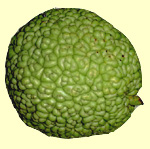 Osage
orange trees stood, sentinel anomalies, in two unkempt
rows, elbowing each other as the westerlies made
them dance. Their exotic offspring, strangely spring-green,
whorled and dimpled, hung suspended in high branches
or lay shucked in puddles downhill of the trees in
varying states of decomposition. Osage orange was
the first tree Lewis and Clark sent back East from
the early stages of their expedition; settlers had
expanded the tree's territory westward by planting
it in shelterbelts. Osage
orange trees stood, sentinel anomalies, in two unkempt
rows, elbowing each other as the westerlies made
them dance. Their exotic offspring, strangely spring-green,
whorled and dimpled, hung suspended in high branches
or lay shucked in puddles downhill of the trees in
varying states of decomposition. Osage orange was
the first tree Lewis and Clark sent back East from
the early stages of their expedition; settlers had
expanded the tree's territory westward by planting
it in shelterbelts.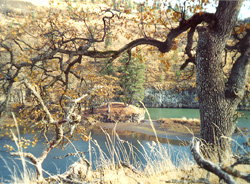
Mostly,
though, umber-leaved oaks and ponderosa pines lined
our path and dotted the rounded hillsides nearby. The
river, as Kerry said, took on a molten metallic quality
in the flat-angled light of approaching winter. David
identified the nearly invisible birds exploding and
resettling in the boughs of the trees above us as bushtits.
We were drawn toward the fenceline separating the mantle
of the hill from its basalt cliffs that dropped down
to the water and a small inlet, now deprived of its
early-season creek source, but still hosting a bevy
of waterfowl.
As we walked along the meadow-topped
hill, I stopped to pick up what looked like a large chestnut
that had split open, and whose meat appeared to be shrunken
(though smooth) and covered with mold or algae—it
appeared shrunken as it didn't fill out its surrounding
leathery, star-shaped shell. I thought it was curious
and pointed it out to David, Kerry and Francis. A few
steps later, I bent down to pick up a similar
“chestnut”, only this one's shell had not
only split open, but had curled back, exposing a cracking,
leathery interior. The inverted corona formed a sort
of pedestal supporting a flattened cushion, whose texture
was quite different. This was no ordinary chestnut, and
there wasn't a chestnut tree in sight. We were puzzled,
but left the two specimens, evidently in varying states
of maturity, on the fence posts and continued on our
walk. 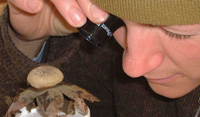
Curiosity got the better of us on
the way back, however, and we scoured the ground for
more clues. We found several more of these odd objects,
most inverted like the second one we'd found. As we looked
closely in the disturbed soil (disturbed, we imagined,
from the recent digging out of the walking path), we
saw divots where more of these fungi–
as we now assumed — were peeking out. Some were
still enclosed in their shell and mostly underground;
some had erupted and were sitting atop inverted crowns
above ground. What a sight! They suddenly seemed to be
everywhere! We had discovered a mushroom none of us had
ever seen before! We inspected the soil from which they
were emerging as well as the surroundings — they
were more or less exposed (not under tree canopy), but
near large oaks. The ground was damp from recent rains,
but it didn't appear that these mushrooms had all emerged
recently; they looked as though they had painstakingly
shrugged their way through the earth's epidermis over
days; perhaps weeks, perhaps months. We collected several
more specimens in varying stages of inversion and decomposition. 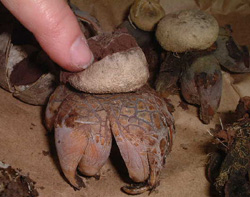 We
used our Private Eye loupes (on loupe-leashes around
our necks, naturally!) to inspect the objects more closely.
The sac in the middle was kid-leather smooth containing
an extremely fine, powdery substance, which in some specimens
had turned a deep, rich brown. In fact, it resembled
cocoa powder. Kerry exclaimed that it reminded her of
puffball mushrooms. We mused and pondered a bit more,
resolving to solve the mystery when we got back to work. We
used our Private Eye loupes (on loupe-leashes around
our necks, naturally!) to inspect the objects more closely.
The sac in the middle was kid-leather smooth containing
an extremely fine, powdery substance, which in some specimens
had turned a deep, rich brown. In fact, it resembled
cocoa powder. Kerry exclaimed that it reminded her of
puffball mushrooms. We mused and pondered a bit more,
resolving to solve the mystery when we got back to work.
My fingers became numb carrying my
small stash of these odd, damp specimens back to the
car through the wind, taking care not to crush them,
though they looked fairly tough.
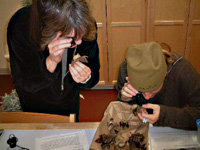 Upon
returning to the office, we dug right into “Mushrooms
of North America”, a field guide to fungi by
Orson K. Miller, Jr., and were able to narrow down
our specimens by closely observing their structures
using our loupes. We then compared the structures we
saw with those in an illustrated glossary in the back
of the book. We looked up the options that seemed most
similar on the internet, and were rewarded with excellent
pictures and detailed descriptions on a site called www.mykoweb.com.
We first ran across something that looked familiar
called Geastrum coronatum *—Earthstars!
How appropriate. They are in the Lycoperdales family,
closely related to…the puffballs! So when Kerry
said that these strange items reminded her of puffballs…she
was headed down the right path. And in our case, a crowned earthstar,
which accounted for the rays that radiated outward
from the central “fruit”. Upon
returning to the office, we dug right into “Mushrooms
of North America”, a field guide to fungi by
Orson K. Miller, Jr., and were able to narrow down
our specimens by closely observing their structures
using our loupes. We then compared the structures we
saw with those in an illustrated glossary in the back
of the book. We looked up the options that seemed most
similar on the internet, and were rewarded with excellent
pictures and detailed descriptions on a site called www.mykoweb.com.
We first ran across something that looked familiar
called Geastrum coronatum *—Earthstars!
How appropriate. They are in the Lycoperdales family,
closely related to…the puffballs! So when Kerry
said that these strange items reminded her of puffballs…she
was headed down the right path. And in our case, a crowned earthstar,
which accounted for the rays that radiated outward
from the central “fruit”.
The habitat description didn't match
ours exactly. True, the earthstars were “gregarious”,
but here, at least, they weren't growing under conifers
or cypress; only the pines and oaks. They did seem to
fit the “fruiting from after the fall rains to
late winter” bit.
I was delighted to stumble across
a whole slew of new vocabulary in poring over the description:
the central nugget of the fruiting body, or sporocarp (spore
sac), was subglobose (not quite round), and
the mushrooms themselves, hypogeous (growing
and ripening underground), then erumpent (breaking
through the surface)... a whole polysyllabic world of
strange colors, textures, structures and consonants had
opened before us! (For more tongue-twisting mycological
morphology, see the links below.) We confirmed that the
cocoa puff gleba (the sporemass, or mycelium,
inside a puffball) was indeed supposed to be dark brown
at maturity. As we read on, however, we found that our geastrum closely
resembles another earthstar, astraeus
hygrometricus**. After following the
web trail to astraeus, we discovered that it
was likely our suspect! 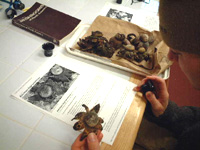
Perhaps
most exciting to us is that the role of these earthstars
in nature is not known for certain; some experts think
earthstars form mycorrhizae (fungi
that form symbiotic relationships with roots of more
developed plants). To figure out what a foreign,
unfamiliar object in our environment was we'd gotten
on the right track using the power of loupe + analogy-provoking
questions. We'd put on our Private Eye hats and solved
one mystery only to uncover a new one—so these
strange objects are Earthstars, but what is an Earthstar,
really, and what role does it play? The puzzler remains
to be solved...
Do
you have any Private Eye adventures—fungal or
just plain fun—you'd like to share with us? We
welcome field
report submissions about what you've discovered
using The Private Eye—one little paragraph or
a whole essay!

*See
the “Naming by Analogy” section on p.143
in The Private Eye guide!
**There
is some scientific debate as to the morphology of and
relationship between geasters and astraeus--see
Tom Volk's Fungus page, below.
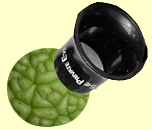
After
researching the osage orange (maclura pomifera),
I found that barbed wire had been designed to mimic
the thorny green hedges of osage, which settlers on
the Great Plains planted close together and pruned
to be, ideally, “horse-high, bull-strong and
hog-tight”. Green branches can also be planted
in the ground and turned into a living hedge. The tree
is named after the Osage tribe of Western Missouri
through Northwestern Arkansas, who prized the wood
of the tree for making bows (another name for the tree
is "bodark", an adaptation of the French "bois
d'arc" meaning bow wood). The wood is also highly
resistant to fungus, which makes it very useful for
fence posts. The dried wood, when burned, has some
of the highest heat output of any native hardwoods.
It turns out that osage orange trees are in the same
family as mulberry trees, and if you were to look at
a mulberry with a loupe, you'd see that its texture
is, in micro scale, very similar to that of the convoluted
surface of the osage orange.
For
more fascinating facts and information about osage
orange trees, see:
http://www.gpnc.org/osage.htm
http://hedgeapple.com
http://www.fs.fed.us/database/feis/plants/tree/macpom/
Plants
of the Lewis & Clark Expedition (H. Wayne
Phillips, 2003), Mountain Press Publishing.
Or
more on earthstars:
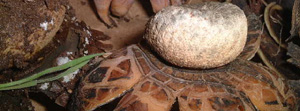 http://www.mykoweb.com/ http://www.mykoweb.com/
Tom
Volk's Fungus of the Month for December 2003
|
